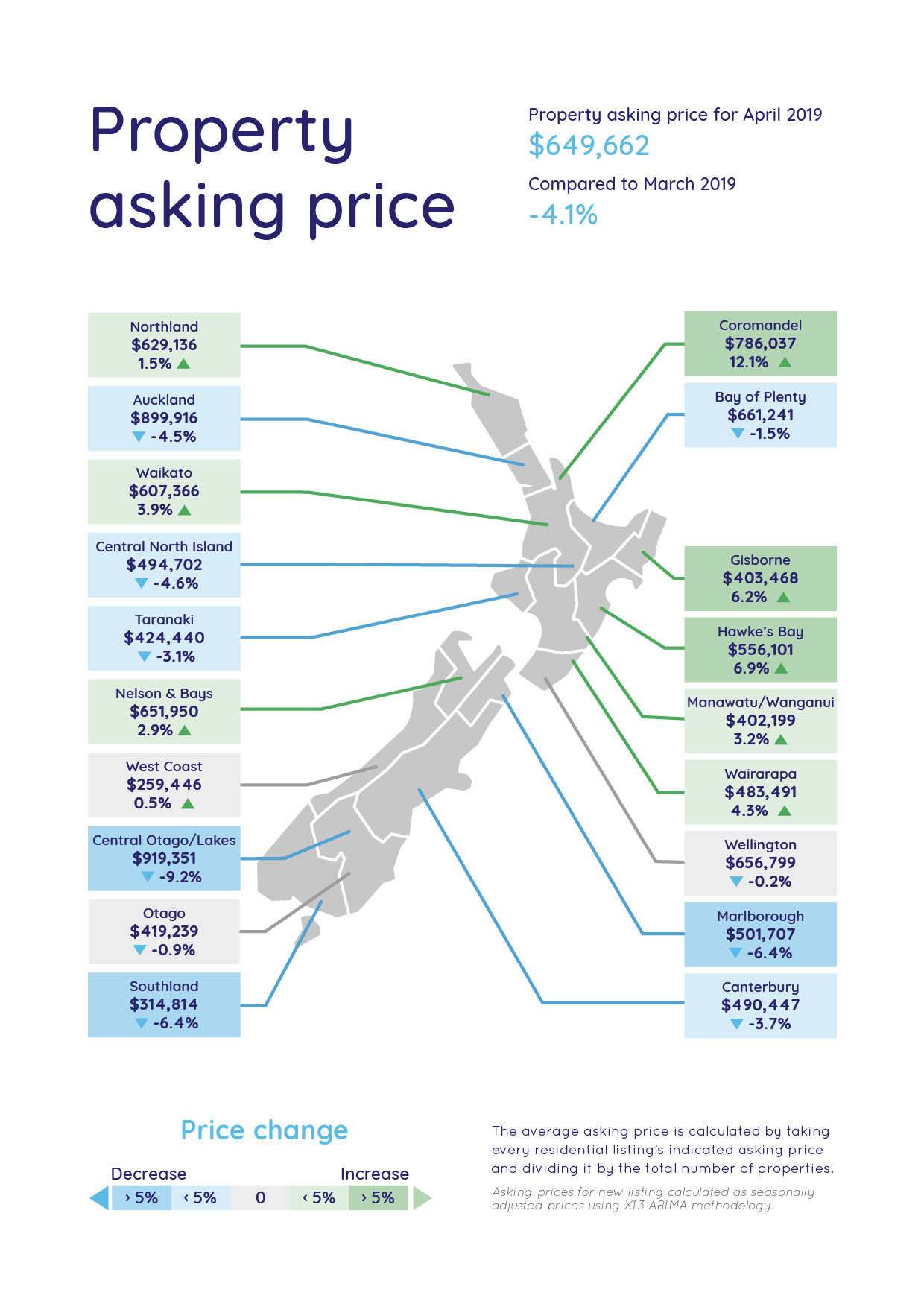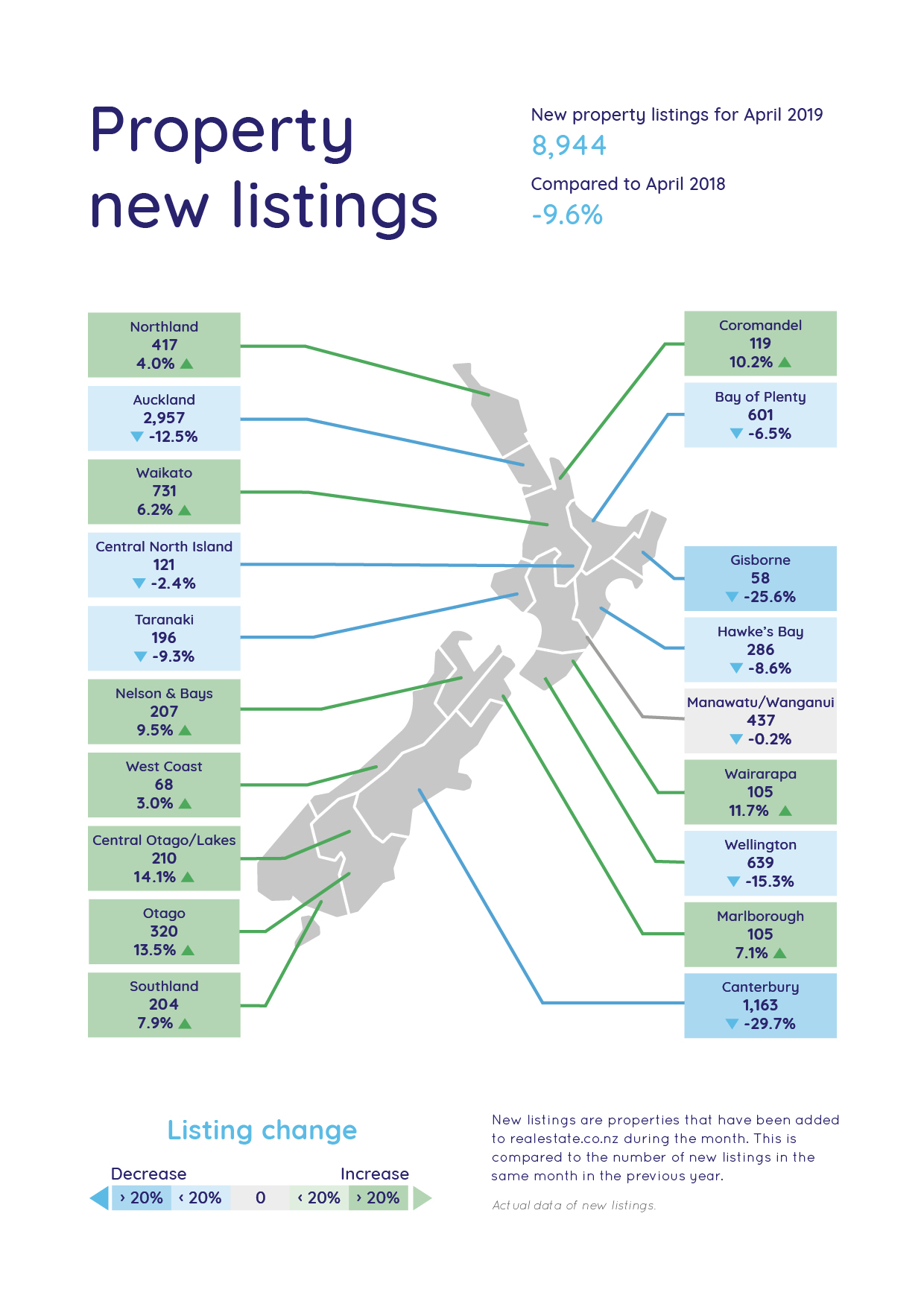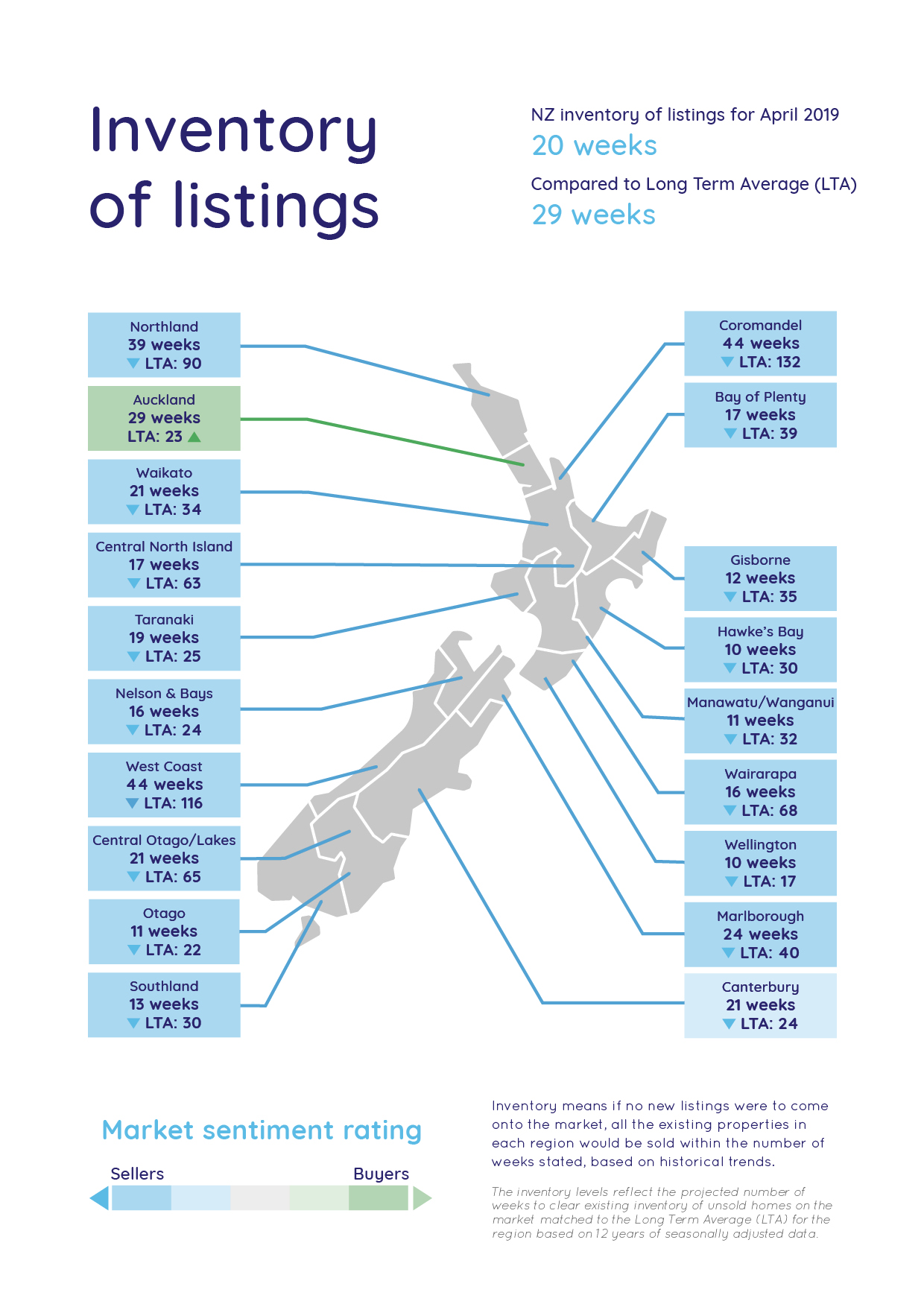Download the full New Zealand Property Report as a PDF.
The Auckland region’s average asking price drops below $900,000 for the first time since 2016, and new listings are down across the country.
All-time asking price highs for Hawke’s Bay, Coromandel and Manawatu/Wanganui regions, since our records began in 2007.
The Auckland region’s average asking price in April dropped to its lowest level since 2016 and houses are taking longer to sell according to real-time statistics from realestate.co.nz.
The region’s average asking price fell 4.5% to $899,916 compared to the prior month and 5.8% compared to the same month in 2018. *The all-time high average asking price for the Auckland region was $982,673 in December 2017.
“We have left behind the frenetic market of 2014 to 2017 where asking prices spiralled dramatically upwards, largely underpinned by fierce competition in the market and an increase in local and offshore investors,” says realestate.co.nz spokesperson Vanessa Taylor.
“We’ve now had two years of stable pricing with a dip in average asking prices in the Auckland region this year,” says Vanessa.
New listings in the region fell in April (-12.5% to 2,957 listings) and compounded with properties sitting on the market for longer, buyers aren’t under the same purchase pressure.
“The current Auckland market is not the new normal, it’s the old normal which was prior to 2014, when there was time to negotiate and ensure that if you sold your house, you also had your new home lined up,” says Vanessa.
“If you sell your house for less than CV, in this current market it’s highly likely that the home you’re purchasing will also sell for less than CV.
“The New Zealand property market can have upsides at the other end of the transaction, and we mustn’t lose sight of this.”
The Auckland market also represents potential opportunity for first home buyers.
“The fall in asking average asking prices in the Auckland region also applies to entry-level homes,” says Vanessa.

All-time asking price highs for the Hawke’s Bay, Coromandel and Manawatu/Wanganui regions
Since realestate.co.nz started collecting data in 2007, it was three of the smaller regions which hit all-time asking price highs in April.
The Manawatu/Wanganui region has even taken this a step further, with all-time asking price highs in two consecutive months.
“The new $402,199 asking price high in April has seen the region breaking into the $400,000 bracket for the first time and is a 3.2% increase on the previous month’s record,” says Vanessa.
“It’s a tightly held, popular region that’s recorded an 11.0% drop in total listings compared with the same time last year,” says Vanessa.
Both Fielding and Levin in the Manawatu/Wanganui region were listed in the top 10 search destinations nationally on realestate.co.nz in April. To be expected, the largest number of people searching on the site in this region were locals, followed by those residing in the Wellington region and then Aucklanders.

Also popular, the Coromandel region has been active, with a new record asking price in April of $786,037 which is up 12.1% on the prior month. The region also received a healthy injection of new listings in April with 119 more homes coming onto the market, that is a 10.2% increase on the previous year.
“This would have been welcomed, as the total number of homes for sale in April stood at 571, which was down 5.7% on April 2018,” says Vanessa.
Online searches for property in the Coromandel region on realestate.co.nz were dominated by Aucklanders.
On the East Coast, the Hawke’s Bay region hit an all-time asking price high of $556,101, which was a 6.9% increase on the prior month.
Nationally, the average asking price in April stood at $649,662 a 4.1% decrease on the previous month which was largely driven by the drop in asking prices in the major centres.

New listings, holidays and Capital Gains Tax
Nationally, new listings were down 9.6% compared to April 2018, with 8,944 homes being listed on the market. By contrast, total stock was up 6.1% compared with April 2018.
“The second half of April was dominated by school holidays, Easter and Anzac Day, which plays a part in the fall in new listings and in the time people had to focus on property in general,” says Vanessa.
“Most noticeably, it was the major regions of Auckland, Wellington and Canterbury which were well down on new listings in April compared to the same time last year,” says Vanessa.
“In the previous month, the Auckland region accounted for a third of all new listings, so a fall in April was not unexpected.
“However, properties are also staying on the Auckland market for longer so there is more overall choice in our biggest region.”

It was also in mid-April (17th) that Prime Minister Jacinda Ardern ruled out a Capital Gains Tax.
“It’s unlikely that this had a major impact on the property market during April given the nature of the month but will be interesting to see what activity this decision drives over the next few months” says Vanessa.

In April 2019, the Real Estate Institute of New Zealand (REINZ) reported that the median house price in Auckland in March fell by 2.7% from the same time last year to $856,000 – down from $880,000.
Bindi Norwell, Chief Executive at REINZ says: “While the cooling of Auckland’s median house price when compared to the same time last year might present some frustration for those looking to sell their house, it is presenting some good opportunities for first home buyers.
The latest Reserve Bank lending figures showing that mortgage lending to first home buyers was up 9.7% on the same time last year which means that more people are able to get a foot on the property ladder which can only be a good thing.”
For media enquiries, please contact:
Alex Dudley, PPR T: 027 5399 555 E: alex.dudley@ppr.co.nz
Glossary of terms:
As the only provider of real estate data in real time, realestate.co.nz offers valuable property market information not available from other sources.
- Average asking price is not a valuation. It is an indication of current market sentiment. Statistically, asking prices tend to correlate closely with the sales prices recorded in future months when those properties are sold. As it looks at different data, average asking prices may differ from recorded sales data released at the same time.
- Inventory is a measure of how long it would take, theoretically, to sell the current stock at current average rates of sale if no new properties were to be listed for sale. It provides a measure of the rate of turnover in the market.
- New listings are a record of all the new listings on realestate.co.nz for the relevant calendar month. As realestate.co.nz reflects 97% of all properties listed through registered estate agents in New Zealand, this gives a representative view of the New Zealand property market.
- Demand: the increase or decrease in the number of views per listing in that region, taken over a rolling three-month time frame, compared to the same three-month time frame the previous year – including the current month.
- Seasonal adjustment is a method realestate.co.nz uses to better represent the core underlying trend of the property market in New Zealand. This is done using methodology from the New Zealand Institute of Economic Research.
- Truncated mean is the method realestate.co.nz uses to provide statistically relevant asking prices. The top and bottom 10% of listings in each area are removed before the average is calculated, to prevent exceptional listings from providing false impressions.
01 May 2019

